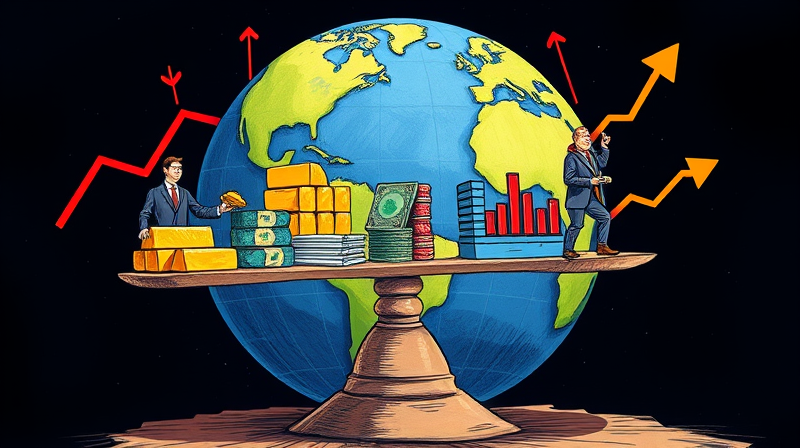As inflation reshapes economies around the world, investors face unprecedented challenges and opportunities. By understanding the forces at play and adapting your plan, you can protect your wealth and thrive in any environment.
Inflation is more than a rising consumer price index—it’s a signal of shifting economic power, policy changes, and market sentiment. Your approach to investing must evolve if you want to stay ahead of these currents.
Understanding the 2025 Economic Landscape
The year 2025 promises moderate global growth with a projected 2.5% rise in world GDP. Trade is expected to slow, dipping to 1.7%, and central banks are offering continued monetary support.
While disinflation trends persist, policy uncertainty looms large, especially in the United States. The incoming administration may trigger both optimism and caution, affecting markets in unpredictable ways.
Tracking Inflation Trends
Inflation forecasts for 2025 vary among experts. Vanguard expects core inflation around 1.5%, Amundi Research projects roughly 2.5%, and J.P. Morgan warns it could remain near 3%.
Markets are highly sensitive to these figures, as bond and equity correlations have turned positive. This means both asset classes now move in tandem when inflation signals shift.
Building a Resilient Portfolio
In periods of rising prices, certain investments have historically provided superior protection. Consider diversifying into:
- Hard assets such as gold, real estate, and collectibles that hold intrinsic value
- Inflation-linked bonds like TIPS, offering automatic principal adjustments
- Commodities that often outpace consumer goods prices over the long run
Hard Assets as the Cornerstone
Physical assets serve as an anchor when currencies lose purchasing power. Gold and precious metals are time-tested hedges, while real estate can generate rental income that often rises with inflation.
Farmland and timberland, though less liquid, tend to appreciate in value as food and lumber costs climb. Collectibles—art, vintage cars—can also offer unique returns if you choose carefully.
Leveraging Treasury Inflation-Protected Securities (TIPS)
TIPS provide direct inflation protection. Their principal adjusts with the Consumer Price Index, so you gain automatically when inflation ticks up.
Backed by the U.S. Treasury, they combine safety with transparency. No active management is required—your holdings simply reflect official inflation measurements.
Commodities for Portfolio Balance
Commodities often signal changes in price trends before consumer goods do. Consider exposure to:
- Energy resources like oil and natural gas
- Agricultural staples such as wheat and corn
- Industrial metals including copper and aluminum
- Precious metals beyond gold, like silver and platinum
Allocating a portion of your portfolio to commodities can stabilize returns when inflation pressures build.
Equities as an Inflation Hedge
Stocks generally adjust for inflation through higher corporate revenues and asset values. For 2025, experts recommend overweighting U.S. and Japanese equities.
Inflation-driven price increases for goods and services often translate into greater company earnings, fueling share-price appreciation over time.
Regional Investment Considerations
Each market offers distinct dynamics. In the United States, potential fiscal loosening and deregulation may boost GDP, but tariffs and reduced immigration could weigh later in the year.
Europe’s central banks are likely to cut rates ahead of the Federal Reserve, offering early relief for borrowers. In Asia, the Bank of Japan continues to tighten, making Japanese stocks a compelling opportunity.
Emerging markets face volatility from U.S. dollar swings, oil price fluctuations, and geopolitical risks. China’s stimulus efforts and potential tariffs under the new administration warrant close monitoring.
Central Bank Divergence and Its Implications
As of 2025, central banks are at different points in their cycles. The Federal Reserve is on pause, eyeing cuts later in the year if disinflation continues.
The European Central Bank and the Bank of England are expected to ease policy sooner, while the Bank of Japan remains in hiking mode. This divergence will drive currency movements and cross-border capital flows.
Actionable Investment Recommendations
Morgan Stanley suggests that the first half of 2025 may favor fixed-income markets as rate cuts materialize. In the latter half, equities should gain relative appeal, especially if merger activity picks up.
To enhance resilience, consider a mix of short-dated bonds, inflation-linked securities, gold, and infrastructure assets. This blend aims to reduce correlation risk and capture upside across scenarios.
Key Risks and How to Prepare
The biggest threat to this outlook is stalled disinflation. If progress reverses, the Federal Reserve might hike rates again, disrupting markets and economic growth.
Corporate earnings could face downward revisions if tariffs intensify, while new low-cost AI models from Chinese firms may pressure global technology leaders. Stay nimble and review your allocations regularly.
Conclusion: Embrace Flexibility and Foresight
Global inflation presents both hurdles and openings for investors willing to adapt. By incorporating diverse asset classes, monitoring policy shifts, and planning for multiple outcomes, you can build a portfolio that thrives under pressure.
Remember that the best strategy combines a clear vision with the agility to pivot. Use these insights to craft a resilient investment strategy that safeguards your future, no matter where inflation heads next.
References
- https://www.imf.org/en/Blogs/Articles/2025/04/22/the-global-economy-enters-a-new-era
- https://www.ishares.com/us/insights/investment-directions-spring-2025
- https://www.morganstanley.com/ideas/global-investment-strategy-outlook-2025
- https://corporate.vanguard.com/content/corporatesite/us/en/corp/articles/investment-economic-outlook-march-2025.html
- https://research-center.amundi.com/index.php/article/global-investment-views-february-2025
- https://www.range.com/blog/inflation-5-wealth-protection-strategies
- https://www.investopedia.com/terms/i/inflation.asp
- https://www.jpmorgan.com/insights/global-research/outlook/market-outlook










